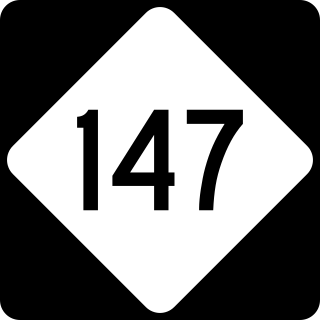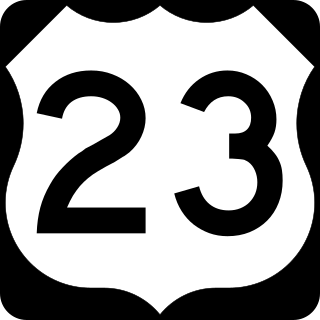
Interstate 40 (I-40) is a major east–west Interstate Highway running through the south-central portion of the United States. At a length of 2,556.61 miles (4,114.46 km), it is the third-longest Interstate Highway in the country, after I-90 and I-80. From west to east, it passes through California, Arizona, New Mexico, Texas, Oklahoma, Arkansas, Tennessee, and North Carolina. Its western end is at I-15 in Barstow, California, while its eastern end is at a concurrency of U.S. Route 117 (US 117) and North Carolina Highway 132 (NC 132) in Wilmington, North Carolina. Major cities served by the interstate include Flagstaff, Arizona; Albuquerque, New Mexico; Amarillo, Texas; Oklahoma City, Oklahoma; Little Rock, Arkansas; Memphis, Nashville, and Knoxville in Tennessee; and Asheville, Winston-Salem, Greensboro, Durham, Raleigh, and Wilmington in North Carolina.

Interstate 244 (I-244), also known as the Martin Luther King Jr. Memorial Expressway since 1984, the Crosstown Expressway, and the Red Fork Expressway, is a 15.8-mile-long (25.4 km) east–west Interstate Highway bypass route of I-44 in Tulsa, Oklahoma.

Oregon OR 126 (OR 126) is a 204.63-mile-long (329.32 km) state highway that connects coastal, western, and central parts of the U.S. state of Oregon. A short freeway section of OR 126 in Eugene and Springfield is concurrent with Interstate 105 (I-105).

New York State Route 895 is a short boulevard in the New York City borough of The Bronx. Its south end is at a merging with the Bruckner Expressway (I-278) in the Hunts Point neighborhood, and its north end is at the Cross Bronx Expressway (I-95), with a short continuation connecting with local West Farms streets. NY 895 is locally known as Sheridan Boulevard.

Interstate 110 (I-110) is an auxiliary Interstate Highway in the U.S. state of Louisiana. It runs 9.06 miles (14.58 km) in a north–south direction as a spur of I-10 in the city of Baton Rouge.
Black Creek Drive is a four lane north–south arterial road in Toronto, Ontario, Canada. It connects Weston Road and Humber Boulevard with Highway 401 via Highway 400, the latter of which it forms a southerly extension. Black Creek Drive officially transitions into Highway 400 at the Maple Leaf Drive overpass, southeast of Jane Street. The roadway is named after the Black Creek ravine, which it parallels for most of its route. It features a maximum speed limit of 70 km/h (43 mph). As a municipal road, it is patrolled by the Toronto Police Service.

Interstate 235 (I-235) in Oklahoma is also known as the Centennial Expressway or the I-235 Central Expressway. The spur route of I-35 is a 5.4-mile-long (8.7 km) north–south alignment in central and north-central Oklahoma City. It connects northbound to U.S. Highway 77 (US-77) to suburban Edmond and southbound at I-44 on to I-35 and the I-40 Crosstown Expressway near downtown Oklahoma City. US-77 is concurrent with I-235 for the entire route. South of its junction with I-40, I-235 becomes I-35.
The Lee Roy Selmon Expressway is a 14.168-mile (22.801 km) all-electronic, limited access toll road in Hillsborough County, Florida, It connects the South Tampa neighborhood near MacDill Air Force Base with Downtown Tampa and the bedroom community of Brandon. The expressway was built in stages, opening between 1976 and 1987. An approximately 1.9 mile extension to the thoroughfare's western terminus opened to traffic on Monday, April 19, 2021.
Oklahoma City is near the geographic center of the United States and is an integral point on the U.S. Interstate Network. The city is served by numerous roads and highways, toll roads, three major airports, a train station, a bus station, and a transit system.

U.S. Highway 90 Business is a business route of U.S. Highway 90 located in and near New Orleans, Louisiana. It runs 14.25 miles (22.93 km) in a general east–west direction from US 90 in Avondale to a junction with Interstate 10 (I-10) and US 90 in the New Orleans Central Business District.

North Carolina Highway 147 (NC 147) is a North Carolina state highway. The route is an 8.1-mile-long (13.0 km) freeway through Durham running roughly southeast to northwest; the entire route lies within the city limits. To the southeast, it connects the city to the Research Triangle Park. NC 147 is the northern half of the Durham Freeway, which continues south onto Interstate 885 (I-885). The route is the main arterial through Durham, running alongside its downtown. It begins at a semi-directional T interchange with I-885 southeast of downtown Durham and runs northwest-southeast before merging into Interstate 85 (I-85) northwest of downtown Durham.

Interstate 40 (I-40) is an Interstate Highway in Oklahoma that runs 331 miles (533 km) across the state from Texas to Arkansas. West of Oklahoma City, it parallels and replaces old U.S. Highway 66 (US-66), and, east of Oklahoma City, it parallels US-62, US-266, and US-64. I-40 is the longest Interstate highway in Oklahoma.

Interstate 44 (I-44) runs diagonally through the US state of Oklahoma, spanning from the Texas state line near Wichita Falls, Texas, to the Missouri border near Joplin, Missouri. It connects three of Oklahoma's largest cities: Oklahoma City, Tulsa, and Lawton. Most of I-44 in Oklahoma is a toll road. In southwestern Oklahoma, I-44 is the H. E. Bailey Turnpike and follows a north–south direction. From Oklahoma City to Tulsa, I-44 follows the Turner Turnpike. As I-44 leaves Tulsa, it becomes the Will Rogers Turnpike to the Missouri border. In the Lawton, Oklahoma City, and Tulsa metro areas, I-44 is toll-free.

Interstate 64 (I-64) passes through the Greater St. Louis area in the US state of Missouri. The entire route overlaps U.S. Route 40 (US 40). Because the road was a main thoroughfare in the St. Louis area before the development of the Interstate Highway System, it is not uncommon for locals to refer to the stretch of highway as "Highway 40" rather than "I-64". On December 6, 2009, the portion of the highway running through the city of St. Louis was named the Jack Buck Memorial Highway in honor of the late sportscaster.

Interstate 75 (I-75) runs from Cincinnati to Toledo by way of Dayton in the US state of Ohio. The highway enters the state running concurrently with I-71 from Kentucky on the Brent Spence Bridge over the Ohio River and into the Bluegrass region. I-75 continues along the Mill Creek Expressway northward to the Butler County line just north of I-275. From there, the freeway runs into the Miami Valley and then passes through the Great Black Swamp before crossing into Michigan.
The Oklahoma City Crosstown Expressway, aka I-40 Crosstown, is a roughly five-mile (8.0 km) stretch of Interstate 40 (I-40) just south of Downtown Oklahoma City, running along the Oklahoma River between Agnew Avenue and the I-40/I-35/I-235 Crossroads of America junction. Prior to 2012, the I-40 Crosstown was an elevated stretch that bisected downtown. The Oklahoma City Crosstown is the de facto east–west artery through Oklahoma City, serving as an unofficial dividing line between north and south Oklahoma City. It is owned and maintained by the Oklahoma Department of Transportation (ODOT).

U.S. Route 23 (US 23) is a United States Numbered Highway that runs from Jacksonville, Florida, to Mackinaw City, Michigan. In the state of Ohio, it is a major north–south state highway that runs from the Kentucky border at Portsmouth to the Michigan border at Sylvania.
The Metropolitan Area Projects Plan 3, or MAPS 3, is a $777 million public works and redevelopment project in Oklahoma City, Oklahoma funded by a temporary voter-approved sales tax increase. The one-cent sales tax initiative began in April 2010 and ended in December 2017. The structure of MAPS 3 is in the pay-as-you-go format of a Metropolitan Area Projects Plan including a temporary sales tax, multiple projects, and volunteer citizens oversight committee.

The Oklahoma City Streetcar, also known as the MAPS 3 streetcar, is a streetcar system in Oklahoma City, Oklahoma, United States, that opened in 2018. The 4.8-mile (7.7 km) system serves the greater downtown Oklahoma City area using modern, low-floor streetcars, the first of which was delivered in February 2018. The initial system has two lines that connect Oklahoma City's Central Business District with the entertainment district, Bricktown, and the Midtown District. Expansion to other districts surrounding downtown as well as more routes in the CBD is planned.
Interstate 885 (I-885) and North Carolina Highway 885 (NC 885) is an 11.5-mile (18.5 km) auxiliary Interstate Highway and state highway in the US state of North Carolina. It links NC 540 and I-40 to I-85 in the Durham area. The route consisted of two preexisting segments of freeway—NC 147 to the south and US Highway 70 (US 70) to the north—connected by the East End Connector, which opened to traffic on June 30, 2022.














